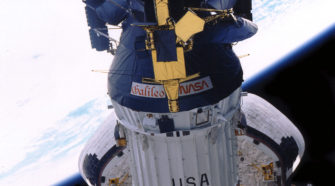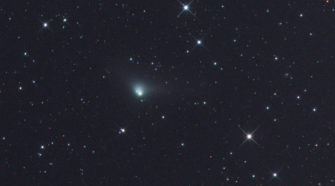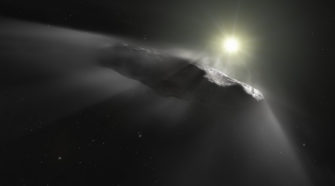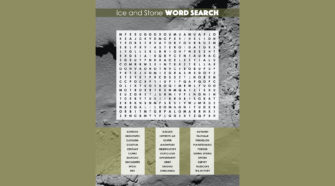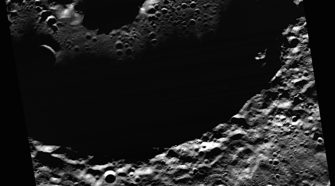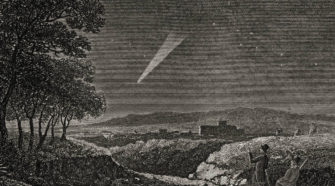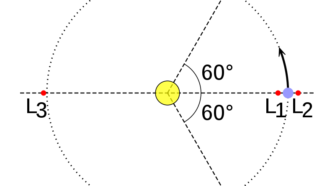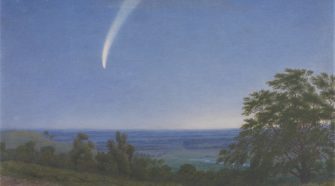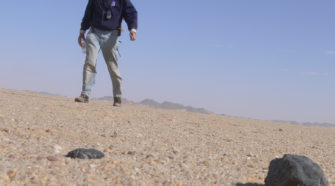Ice and Stone
This Week in History: October 18-24
OCTOBER 18, 1977: Charles Kowal discovers the first-known centaur, (2060) Chiron, with the 1.2-meter Schmidt telescope at Palomar Observatory in California. Centaurs are the subject of a previous “Special Topics” presentation. OCTOBER 18, 1989: NASA’s Galileo mission is deployed from the Space Shuttle Atlantis, with its final destination being Jupiter. While en route to Jupiter …
Comet of the Week: Siding Spring C/2013 A1
Perihelion: 2014 October 25.30, q = 1.399 AU Of the various comprehensive survey programs that have been operational since the first such programs commenced in the late 1990s, only one has been based in the southern hemisphere: the Siding Spring Survey, based at its namesake observatory in New South Wales and which operated with funding …
Special Topic: 1I/‘Oumuamua
While the details are always in a state of revision, for quite some time now the general consensus among astronomers as to how the solar system and its planets formed involves the accumulation of smaller objects, “planetesimals.” The comets and asteroids we see today, and that have been the primary focus of “Ice and Stone …
Ice and Stone 2020 Word Search #3
Do your best to find these words that are scattered throughout the 43rd weekly edition of Ice and Stone 2020. Words may be placed horizontally or vertically. Letters in the grid may be used in more than one word, but not all the letters in the grid have to appear in a word. More from Week …
This Week in History: October 11-17
OCTOBER 11, 1983: The InfraRed Astronomical Satellite (IRAS) spacecraft discovers the “asteroid” now known as (3200) Phaethon. Phaethon had the smallest perihelion distance of any asteroid known at the time and was soon found to be traveling in the same orbit as the Geminid meteors, suggesting it may be their parent object and thus may …
Comet of the Week: The Great Comet of 1811
Perihelion: 1811 September 12.76, q = 1.035 AU Once the orbital calculations for Comet Hale-Bopp C/1995 O1 were made and it appeared that it would be making a “Great Comet” display a year and a half in the future, it was natural for those of us at the time to search for historical analogs. A …
Special Topic: Trojan Asteroids
In any orbital configuration involving two, and only two, objects – for example, Earth and the sun – the orbital motion can be solved directly from Isaac Newton’s Law of Universal Gravitation; the mathematical solution is complete and analytical. As soon as additional objects are added to the mix, however, things become much more complex, …
This Week in History: October 4-10
OCTOBER 4, 2020: The main-belt asteroid (1679) Nevanlinna will occult the 7th-magnitude star HD 224945 in Pisces. The predicted path of the occultation crosses Newfoundland, part of the Maritime Provinces of Canada, the northeastern through the south-central U.S. (including Houston, Texas), north-central Mexico (including the northern regions of Monterrey, Nuevo Leon), and the southern Pacific …
Comet of the Week: Donati 1858 VI
Perihelion: 1858 September 30.46, q = 0.578 AU Among the many individuals who made important contributions to astronomy during the mid-19th Century was the Italian astronomer Giovanni Donati, who observed from the Observatory of Florence and who was Director of that institution from 1864 until his death (at age 46) in 1873. He made the …
Special Topic: 2008 TC3 and the Almahata Sitta Meteorite
The “Special Topics” presentation three weeks ago discussed actions that we might take should we detect an asteroid that appears will impact Earth. The first and foremost task is the collection of as much data as possible in order to refine the orbit and the likelihood of an actual impact, and if this continues to …

